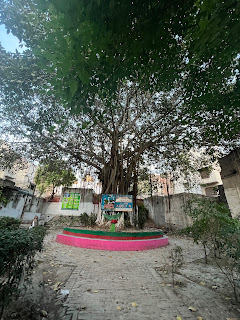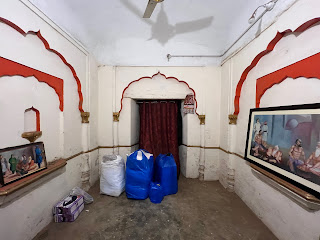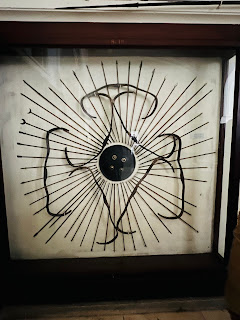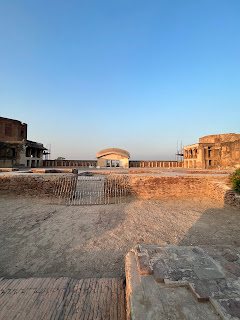1. Gurdwara Dera Sahib (Sri Guru Arjan Dev Ji Shaheedi Asthan)
Located next to the Lahore fort, this is the site where Guru Ji disappeared into Ravi river after several days of torture by Chandu. Underneath this asthan is a well where Guru Mahraj had their final ishnaan. The exterior of this asthan is currently under renovation.
2. Samadh of Maharaja Ranjit Singh Ji
This asthan and the Shaheedi Asthan of Sri Guru Arjan Dev Ji Mahraj are both situated in Gurdwara Dera Sahib, Lahore, Pakistan. Behind the Samadh of Maharaja Ranjit Singh Ji is the Samadh of his son, Kharak Singh and grandson, Naunihal Singh. The fort gate from which a huge boulder fell on Naunihal Singh leading to his death after performing cremation of his father can also be seen in the compounds of this Gurdwara.
3. Parkash Asthan of Sri Guru Ram Das ji
The asthan is sarounded by Chuna Mandi which is still actively running and is a renowned wholesale market. The ancestral home of Sat Guru Ji was very small so when Kanwar Kharak Singh was born to Maharani Nakain she asked her husband, Maharaja Ranjit Singh, to rebuild the Gurdwara to celebrate the birth of her son. Maharaja Ranjit Singh purchased the surrounding buildings from the Qazis and built the asthan in the style of Sachkand Sri Harmandar Sahib.
Next to the Parkash Asthan of Guru Ram Das Ji, this brick building which can be seen from the stairs climbing up from the Parkash Asthan was the Dharamshala of Guru Ram Das Ji used to be at. It was later the Diwankhana (where Guru Mahraj holds their Diwan) of Guru Arjan Dev Ji Mahraj. This is also the site where Guru Mahraj wrote and sent the 3 letters beginning from ਮੇਰਾ ਮਨਿ ਲੋਚੈ ਗੁਰ ਗਰਸਨ ਤਾਈ to their father in Amritsar Sahib.
4. Gurdwara Shahid Ganj Singh Singhania This Shaheedi asthan is of those that gave up their lives but not their faiths during the rule of Mir Mannu. Sikhs were beheaded and their families were put in the Lahore jail (where the asthan is currently). Every woman was given forty pounds of grain to grind for each day in jail. A very heavy stone was placed on the chest of one who could not grind. Their children were transfixed on javelins before their very eyes. Their children were cut into pieces and garlands of those pieces were put around their mother's necks. They were given a quarter of bread to eat and a bowl of water in the whole day. Bowing to the will of Akaal Purakh, they tolerated it all.
Video link: Gurdwara Shahid Ganj Singh Singhania
5. Shaheedi Asthan Bhai Taru Singh Ji
Door to Shaheed Bhai Taru Singh Ji's Shaheedi asthan which is right beside the Singh Singhania asthan but it is currently sealed. There is a land dispute currently ongoing there.
6. Shaheedi Asthan Bhai Mani Singh Ji

This asthan is situated in a room at the back of a shop and marks the site where the Shaheedi of great martyr Bhai Taru Singh Ji took place.
Video link : Shaheedi Asthan Bhai Mani Singh Ji
7. Laal Khu


This asthan is located at the site where Chandu kept Sri Guru Arjan Dev Ji Mahraj in a dingy cell in a part of his mansion. Guru Mahraj was tormented and tortured at this very place. When Chandu was handed to Guru Hargobind Ji Mahraj by Jahangir, he was dragged through this same bazaar and place where he tortured Guru Arjan Dev Ji Mahraj. The name Lal Khu is because there was a red well at this area. The people of old Lahore still place oil lamps here to make a "Wish" or "Mannat" in the memory of friendship between Hazrat Mian Mir with Guru Arjan Dev ji Mahraj. During Guru Ji's imprisonment, Hazrat Mian Mir came to visit Guru Ji and wanted to intercede with the emperor to release Guru Ji but was refused by Guru Ji. He prayed for Guru Ji and according to some tradition, he would even try to bring barfi for the Guru at this Laal Khu.
8. Gurdwara Shri Guru Hargobind Sahib Ji
This asthan marks the site where Mata Kaulan Ji was rescued by Guru Hargobind ji Mahraj. The asthan is currently going through renovation. The new building will also include rooms for students that come to study at Lahore as it is an educational hub and the location of thie Guru Ghar is very strategic. This asthan is situated on the Temple Road which is said to be called such because of the existence of this
Gurdwara.
9. Gurdwara Pehli Patshahi
This is the only asthan associated with Guru Nanak Dev Ji Mahraj in inner Lahore. This asthan was the house of a wealthy Khatri of Lahore, Duni Chand to whom Guru Nanak Dev Ji gave a needle. Guru ji asked him to give return the needle in the world hereafter to make him realise that his wealth will not go with him when he leaves.
10. Gurdwara Baoli Sahib Guru Arjan Dev Ji



This Baoli bagh is the site of Gurdwara Baoli Sahib Guru Arjan Dev Ji. This is the site where the Baoli Sahib used to be at. Many years later however, during the reign of Shah Jahan, this holy Gurdwara was demolished. The Baoli was filled with earth. In Samvat 1891, during the reign of Maharaja Ranjit Singh the Baoli was restored when a florist informed him about it. It is also said that Maharaja Ranjt Singh Ji was pretty sick and a Nihung Singh told the Mahraja that he should get this Baoli Sahib restored and he shall get well.
This place is also said to have been gifted by Guru Ram Das Ji's dadke to them. And later on, it was inherited by Guru Arjan Dev ji who made it a place for Sanggat to assemble and hold Darbar. Prithi Chand was against this as he claimed this is a family land and he should get a portion of it. This matter went to the court. Prithi Chand figured out that the judge is a shardalu of Mian Mir Ji and he was afraid that he will be arrested since Mian Mir ji was close shardalu of Guru Ji, so he did not turn up for the case hearing. This resulted in the case to be dismissed because the person who lodged (Prithi Chand the case did not turn up for the hearing.
11. Gurdwara Janam Asthan Bebe Nanaki Ji.
This asthan is on the site where Guru Nanak Dev Ji Mahrai's Nanake was (maternal grandparents). Since it is a tradition where the first child is birthed at the mother's village, Bebe Nanaki being the first child is born here. Guruji also occasionally used to visit their Nanake here. The Bebe Nanaki ji asthan is located at Dera Chahal village on the Bedian road which is the old route connecting Amritsar Sahib and Lahore. The road is named Bedian as it leads to the Bedian village where residents of the Bedi lineage lived before partition.
Video link : Gurdwara Janam Asthan Bebe Nanaki JI
There are many other asthans in Lahore, some which are sealed while some that needs more exploration.
12. The Buddhu's Tomb

Bhai Buddhu Ji was a devotee who did benti to Guru Arjan Dev Ji Mahraj for his bricks to be baked well which Guru Ji granted him a boon. Later, when he saw that his bricks has baked well, he organised a Langgar. Later, some time after the Langgar, a Sikh of Guru Mahraj, Bhai Lakhu ji came and asked for Langgar from Bhai Buddhu Ji. As he came late and seemed like a Mastana, Bhai Buddhu Ji did not give him any food, saying that the Langgar time has passed. Bhai Lakhu got upset and said your bricks shall remain half baked. His words became true.
Bhai Buddhu Ji came to Guru Arjan Dev Ji again to ask why did his bricks remain half baked. Guru Ji asked him if he has refused Langgar to any Sikh, and Bhai Buddhu Ji explained that a Mastana who came very late. Guru Ji said that "the Bachan of my beloved Sikh (Bhai Lakhu Ji) cannot be turned back". However, at the same time, Guru Ji also initially gave him the Bachan that his bricks will sell well. So Guru Ji said, therefore your bricks shall remain half baked as per Bhai Lakhu Ji's bachan but it will still sell on fully baked bricks price. At that time, it kept raining and a large wall of the fort fell which needed to be rebuilt immediately which resulted in Buddhu ji's half baked bricks to be sold at price of bakes bricks. The whole area near the tomb was where Bhai Buddhu Ji's kiln used to be at. We know this because of this old pillar:

13. Lahore Fort
Lahore Fort was originally built by the Mughal emperor Akbar who demolished the earlier mud fort, and re-built it in burnt brick in 1566. Akbar's successors, Jahangir, Shah Jahan and Aurangzeb added several buildings to the fort. Maharaja Ranjit Singh added many features to the fort during their region including the fortification wall and the glass in Sheesh Mehal.

Lahore Fort has a Sikh Museum – the Princess Bamba Collection. Princess Bamba was the daughter of M. Duleep Singh. Most of the items in this collection were brought back from England. Princess Bamba spent her last days living in Lahore. The Sikh Museum presents unique collection of arms and weapons used by the Sikh Army during the 18th and 19th century when the British occupied the fort in 1046 a.d. they found a considerable number of arms and weapons belonging to Sikh Raaj. The interesting collection ranging from primitive bow and arrows to full-fledged artillery cannons, amply depicting advancement in the manufacture of armaments. The material displayed includes photographs of Sikh rulers and dignitaries, weapons of war, litho prints depicting battles between the Sikh and the British, and a taxidermied horse with original gold trapping used by Maharaja Ranjit Singh Ji.
The Sikh Gallery is situated in Maharani Jind Kaur's Haveli
Maharaja Ranjit Singh Ji's Personal Gurdwara
Maharaja Ranjit Singh ji used to spend a lot of time in this rooftop room. They used to listen to Sri Guru Granth Sahib Ji's Path recitation from a Pathi here. It is said that they also passed away here.
This Gurdwara or also known as Naag Gurdwara was built by Chand Kaur, the wife of Kharak Singh. It is said this Gurdwara was for the Raniyan.
This is said to be the site where Bhai Bidhi Chand Ji rescued the two Guru Ji's stolen horses Gulbagh and Dilbagh and brought it to Guru Hargobind Ji Mahraj.
Ath Dara (8 Openings) - Maharaja Ranjit Singh ji used to hold their Darbar here.
This wall is called the Sikh Wall because they were built by Maharaja Ranjit Singh ji. It is also said that this walls has relation with changing course of the Ravi river and a protection Gurudwara Dera Sahib (Shaheedi asthan of Guru Arjan Dev Ji)
The wall is built on the suggestion of Hari Singh Nalwa and it is built with bastions and holes for musketry as well as arows.
This one dome has about 20 holes on different directions.
If you go to the fort, you should take a guide to know more about specific places. I took this tour guide who had some knowledge about Maharaja Ranjit Singh Ji's shrines and also his narration of Bhai Bidhi Chand Ji's horse rescue story was also aligned with our ithihas.

















































